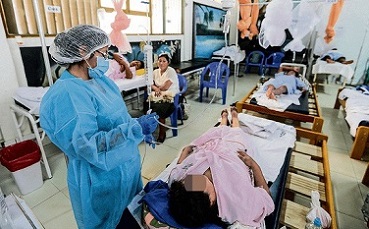Dengue News: Dengue Crisis In Peru Continues With More Than A Quarter Million Infections So far And 419 Deaths And A Collapsing Healthcare System!
Nikhil Prasad Fact checked by:Thailand Medical News Team Sep 23, 2023 1 year, 6 months, 3 weeks, 6 days, 11 hours, 28 minutes ago
Dengue News: Peru is currently grappling with a catastrophic dengue fever outbreak, marking one of the worst epidemics in Latin American history. With a staggering quarter million infections and 419 fatalities nationwide, the country is in the midst of a health crisis that threatens to collapse its already fragile healthcare system.
https://www.dge.gob.pe/sala-situacional-dengue/diaria/

The Tragic Tale of a Mother's Loss
In a heart-wrenching account, a grieving mother from Peru's northern city of Piura shares the tragic story of her 11-year-old child. She believes her child contracted dengue at school in June, which led to a rapid and devastating decline in their health. The child began experiencing severe vomiting and excruciating body pains, followed by alarming bleeding from their eyes. Despite an emergency flight to Lima and the tireless efforts of the country's leading medical specialists, the child succumbed to the disease within a week. The mother, overwhelmed by grief, describes the whirlwind of her child's demise, leaving her feeling isolated and empty.
Her story is not unique as many children are the contracting the dengue disease in Peru and most of the recorded fatalities are being witnessed in children! Daily local
Dengue News in Peru are full of similar stories.
Piura: The Epicenter of the Crisis
Piura, the capital city of Peru’s northwestern Piura region has emerged as the epicenter of Peru's dengue outbreak, with over 75,000 confirmed cases and a quarter of the total deaths in the country. The surge in cases has placed immense pressure on the already-strained healthcare facilities in the region. Doctors report treating up to 80 patients a day, overwhelming their capacity, while the processing of test results has taken as long as 20 days during the peak of the outbreak. The situation in Piura is dire, with healthcare facilities lacking adequate resources and staffing.
Factors Fueling the Dengue Surge
Several factors have contributed to the alarming rise in dengue cases in Peru. Urbanization, driven by rapid population growth and increasing population density, has brought humans and mosquitoes into closer contact, facilitating the transmission of the disease. Ineffective mosquito control measures and the impact of climate change, which prolongs the mosquito lifespan and alters transmission zones, have also played a role.
Past studies have warned that if carbon emissions continue at current levels, 8.5 billion people could be at risk of dengue by the end of the century. This projection represents a significant increase from the 1970-1999 average, potentially exposing 4.7 billion more individuals to the disease.
Challenges in Dengue Management
Dengue, a disease with no cure, often presents as asymptomatic or with mild symptoms but can be fatal in some cases. While two vaccines have been approved for use in the European Union, none have received approval in Peru.
Government measures to combat the o
utbreak include fumigation to eliminate mosquito larvae and public campaigns promoting the use of mosquito nets and the prevention of open water receptacles. However, critics argue that the Peruvian government's response has been hampered by incompetence and inadequate funding for epidemic surveillance.
Healthcare Workers' Struggles
Healthcare workers in Piura and elsewhere in Peru have faced significant challenges, including low wages and insufficient funding. Their protests have highlighted the meager financial support received from the central government, with the region receiving only a fraction of the requested funding to combat dengue. Despite the high risk of infection in areas like Piura, where poverty rates are high and access to municipal water networks is limited, residents report a lack of protective measures and government assistance. Frustration and despair are palpable among those who feel abandoned by the authorities.
Lambayeque's Mismanagement and Its Consequences
In Lambayeque, the mismanagement of the dengue crisis has had dire consequences. The Regional Governor's appointment of an inexperienced Executive Director, Antonio Durand Vásquez, led to a surge in dengue cases and deaths. Subsequently, a qualified professional was appointed, leading to a successful reduction in cases through larvicides and mass fumigations. However, inexplicably, Durand was reinstated as Executive Director, dismantling the effective response and putting Lambayeque's population at risk once again.
The Urgent Need for Competent Leadership
As the El Niño phenomenon looms, it is essential for the Regional Government of Lambayeque and the Peruvian government to prioritize the health and safety of their citizens. The ongoing dengue crisis and the potential impacts of El Niño require decisive and competent leadership. Experienced professionals must lead efforts to protect vulnerable populations from health emergencies, and political considerations should not supersede public well-being.
Conclusion
The dengue crisis in Peru represents a grave threat to public health and highlights the vulnerability of healthcare systems in the face of emerging diseases. The country's response has been marred by inadequate resources, political turmoil, and a failure to learn from previous health crises, such as the COVID-19 pandemic. Urgent action is needed to bolster healthcare infrastructure, allocate sufficient funding, and implement effective mosquito control measures. Only with a comprehensive and coordinated effort can Peru hope to mitigate the devastating impact of the dengue epidemic and safeguard the lives of its citizens.
For the latest
Dengue News, keep on logging to Thailand Medical News
